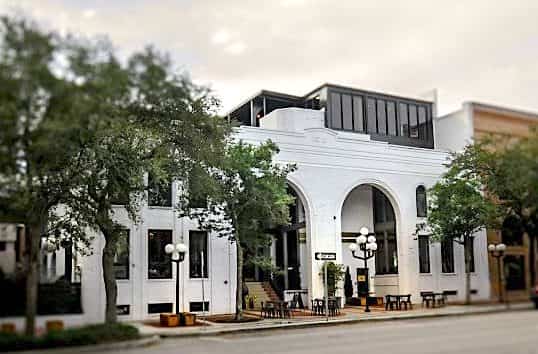Know
Station House, Coronet 300, Bodega buildings in line to become local historic landmarks

Most of us think of Station House St. Petersburg as an office, coworking and event space.
But the building, at 260 1st Ave. S., was built more than 100 years ago as a warehouse to serve the Orange Belt Railway, at a time when trains were common in downtown St. Pete.
That pedigree was prominent as the city’s Community Planning and Preservation Commission voted unanimously to recommend designating the structure a local historical landmark to be listed in the St. Petersburg Register of Historic Places.
The commission recommended the same designation for Coronet 300, a 10-story apartment building at 300 Central Ave. that shares ownership with Station House, and for the Smalley-Green Auto Building at 1180 Central Ave., the property that now houses Bodega.

Steve Gianfilippo
The buildings’ owners asked for the designations, which will allow them to pursue adaptive reuse, certain tax credits and exemptions, and variances, according to a report from the city’s staff to the commission. It will be up to the St. Petersburg City Council to make a final determination after a public hearing.
Steve Gianfilippo, who owns Station House and Coronet 300, previously won local historic landmark designation for another property he owns, the Green-Richman Arcade at 689 Central Ave.
“The city has a matching grant program we used for improvements on the Arcade building. We made improvements to the HVAC, roof, awning and signage. We went through the process last year and this year and it worked well,” he said.
“So with two other buildings that qualify … we wanted to get through Step 1, take advantage of that program and then potentially other programs that are available at the county level with tax abatements.”
He anticipates a cosmetic facelift at Station House. The 300 Central building is in line for bigger changes. Gianfilippo plans to develop that property as “The Mason,” a live-work space with furnished apartments that can double as homes and offices. He hopes to start that project toward the end of this year or in the first quarter of 2021, and complete it by the end of 2021.
History lesson
Tuesday’s Community Planning and Preservation Commission served as a history lesson about the development of downtown St. Petersburg.
The oldest of the three structures considered at the meeting, Station House was built in 1911 as Springstead Warehouse facing the railroad tracks along First Avenue South. A few months later, in 1912, Holland Hotel opened with 20 guest rooms in an upper floor. The building was remodeled in the 1980s for use as office space, when the arches that dominate the front of the structure were added.

A 1963 photo of a train at what is now Station House was included in the presentation to the Community Planning and Preservation Commission.
Station House “conveys its commercial and industrial history as a freight-oriented early 20th century warehouse building. Further the loss of the majority of historically similar buildings that were associated with the railroads in downtown heightens the building’s significance because this is one of the lone survivors. It is a rare reminder of an important part of St. Petersburg’s historical framework,” Laura Duvekot, an historic preservationist in the city’s division of urban design and historic preservation, told the commission.
She said the building meets the three tests for historic landmark status: age, significance and integrity.
Coronet 300 was built in 1924 and originally housed the J. Bruce Smith department store. The contractor was Franklin J. Mason, who had built the nearby Princess Martha Hotel.
“The skyscraper, as it was considered at the time, was hailed as an indication that booming St. Petersburg was graduating from a town oriented toward industry to a more sophisticated city whose economy would focus on tourism and the leisure of winter residents,” Duvekot said.
The department store fell on hard times during the Depression, and the building went through several ownership changes and uses until it was acquired by St. Petersburg Progress Inc. – now the St. Petersburg Downtown Partnership – and converted into apartments.
It also meets the three tests for historic landmark status, Duvekot said.
The third building, the Smalley-Green Auto Building at 1180 Central Ave., was built in 1921 in an area of town that was quickly shifting from residential to commercial, said Kelly Perkins, historic preservationist with the city. It originally was constructed as an electrical service station that specialized in automobile electrical equipment, and later housed a paint company, a furniture store, a gun shop and other retail uses. It’s now owned by developer Blake Whitney Thompson, and Bodega, a popular Latin restaurant, moved into the site on Aug. 13.
The highly ornate building is notable for its blend of Spanish and Italian architecture, with elements of art deco, Perkins said
The building is adjacent to The Edge Collective, a mixed-use retail, hotel and co-working development planned by PTM Partners, a Miami-based real estate and development firm.
“One of the main reasons we originally purchased the parcels on Central Avenue was the unique pedestrian experience along the street. We’re really happy to see the city further supporting this feel,” Michael Tillman, CEO of PTM Partners, said during the public hearing part of the Community Planning and Preservation Commission’s meeting. “I hope the designation will be used as an opportunity to invest in and preserve the facade of the building.”
He also pointed out that the front of the building is distinct from the rest of the structure, which is more utilitarian in nature, adding, “I would not want any issue of anyone mistakenly pointing to those elevations as being a reason to block future development.”







